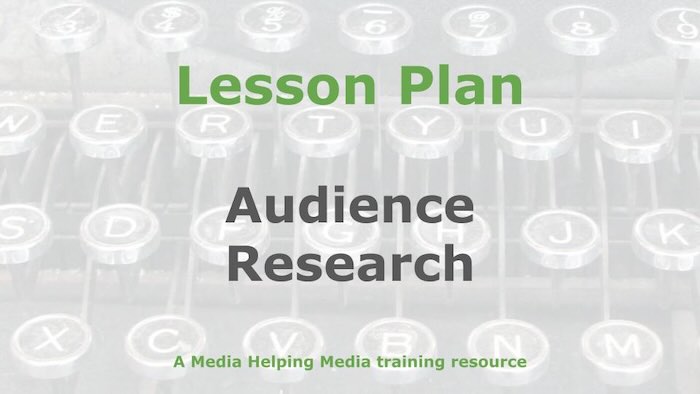 In a rapidly shifting media landscape, where consumers have more choice than ever, a deep understanding of the audience has become essential for all media companies.
In a rapidly shifting media landscape, where consumers have more choice than ever, a deep understanding of the audience has become essential for all media companies.
Relying on assumptions or outdated notions of who your readers, viewers, or listeners are is a recipe for failure. This is why audience research and audience segmentation are so important.
Together they provide the critical insights needed for a media business to stay relevant, build trust, and create compelling content and a sustainable business model.
Whether you are launching a new media venture or steering an established brand, robust audience research and precise audience segmentation form the bedrock of sustainable success.
1. Knowing your audience
Audience research helps a media organisation move beyond surface-level demographics and uncover the motivations, behaviours, and needs of the audience. It answers five main questions:
- News: What are the daily concerns and interests of the audience?
- Platforms: How does the audience consume media, and on which platforms?
- Style: What tone and language resonate with the audience?
- Values: What would turn the audience off or cause them to disengage?
- Revenue: What are the products and services the audience segments frequently buy or aspire to buy?
Some media companies invest in expensive third-party research to find answers to these four questions, but if you are a small media house with limited funds you can do this exercise by sending half a dozen staff out on the street with clipboards for an hour or two.
But first you need to bring together representatives from your editorial, sales, marketing, and business development teams in order to pool existing knowledge and make informed, data-backed assumptions.
As outlined in our article ‘Knowing your audience‘, effective media operations begin with a clear understanding of what audiences want and need.
The audience is looking for information that helps them make sense of their lives and the society they live in. They will want to understand what is behind the news so that they can make informed decisions.
Through research methods such as focus groups, interviews, audience surveys, and analytics, media businesses can uncover these needs and preferences.
Without this understanding, a news organisation risks producing content that is out of touch or irrelevant.
When a media organisation knows its audience’s information priorities, it can respond to that audience need ensuring the five points mentioned earlier are addressed:
- News: Ensure its editorial agenda serve the audience better by covering the news that matters to the audience. See our articles ‘The value of audience research‘ and ‘Establishing a market differential with original journalism‘.
- Platforms: Delivered that content in the most efficient and effective way to the platforms most used by the audience. See our article ‘Adapting to audience behaviour‘.
- Style: Train all staff in the ‘house style’ of the news organisation ensuring that the tone and language of all content served is of the highest-quality expected by the audience. See our article about ‘Language and style‘.
- Values: Maintain the brand values in order to increase trust and loyalty. See our articles ‘Brand values in news‘ and ‘Why editorial ethics are important‘. You might also find ‘Winning audience trust and loyalty‘ helpful.
- Revenue: Serving adverts for the products most likely to be useful to the target audience. See our article ‘How to develop a media sales strategy‘.
2. Audience segmentation
Segmentation breaks your broad audience into manageable groups based on shared characteristics.
These might include lifestyle, professional interests, media habits, age group, location, or values.
Advertisers have long used this approach to “super-serve” their audiences by focusing effort where it delivers the greatest return. Media outlets can (and should) adopt the same practice.
For example, you might define segments such as:
- Young urban professionals seeking career insights.
- Rural communities interested in agriculture and local development.
- Parents looking for trustworthy family and education news.
 By imagining a specific character for each segment – complete with photo, name, lifestyle, and preferences – you humanise your audience.
By imagining a specific character for each segment – complete with photo, name, lifestyle, and preferences – you humanise your audience.
These “audience personas” – see an example on the right – become guiding stars for your journalists and commercial teams alike.
Printed profiles on newsroom and sales department walls serve as daily reminders of whom you serve, ensuring a united, audience-first approach across the organisation.
For journalists, the personas are a reminder that every article is written for them and needs to cover the issues that concern them most.
No audience is homogeneous. Our article ‘Setting up a media business‘ emphasises the importance of defining clear audience segments early in the business planning process.
Segmentation allows media companies to categorise audiences into specific groups based on shared characteristics – such as age, location, lifestyle, interests, or values.
This precision matters enormously. For example, younger audiences might prefer short, visual storytelling on social platforms, while older audiences might seek in-depth analysis delivered via newsletters or podcasts.
Once a media organisation knows what the audience wants it can focus effort and channel resources in order to deliver that information
Segmentation empowers media businesses to deliver the right content, in the right format, at the right time. This increases engagement and deepens audience loyalty.
Clear audience segments are also highly attractive to advertisers and sponsors, offering them well-defined communities for targeted campaigns.
See ‘Developing a media sales strategy‘.
3: Aligning content and commercial strategy
Once your audience segments are clear, everything from editorial planning to advertising strategies becomes more targeted and effective.
- Journalists can craft stories with specific readers in mind, using the language and formats they prefer.
- Sales teams can align advertising placements with audience interests, increasing the likelihood of engagement and revenue.
- Marketing teams can build campaigns around the lifestyles and priorities of each segment.
4: Continuous review and relevance
Audiences evolve, and so must your understanding of them. Regularly revisit and refine your audience profiles and segmentation. A once-reliable model can quickly become outdated as trends shift, technologies change, and new needs emerge. See our article ‘Newsroom evolution from digital denial to digital first‘.
Ultimately, audience research and segmentation empower media organisations to:
- Build deeper trust with their readers.
- Create more impactful and relevant journalism.
- Monetise effectively through tailored advertising and partnerships.
- Establish a distinct identity in a crowded market.
Continuous monitoring of audience behaviour, trends, and feedback ensures that the content production and distribution strategies remain agile and relevant.
Regularly updating audience profiles and segment insights allows media businesses to anticipate changes rather than react to them.
Whether it’s adopting new platforms, adjusting tone, or exploring emerging content formats, staying ahead of audience expectations keeps you competitive.
5. Building trust and enhancing impact
When media businesses genuinely understand and respect their audiences, they create stronger, trust-based relationships.
Audience-centric content strategies signal that the media house is not just broadcasting and publishing information AT the audience, but it is listening and responding to community needs in order to publish content FOR the audience. Media organisations are there to serve their audiences, not themselves.
Thoughtful audience segmentation supports responsible journalism. By recognising the diversity within the audience, a media organisation can address various social, cultural, and regional contexts with care, contributing to a more inclusive media environment.
Conclusion
In summary, audience research and segmentation are essential pillars of a successful media business. They help managers understand the ever-evolving information needs of their audience, tailor content effectively, attract valuable commercial partnerships, and remain agile in a competitive market.
These strategies transform a media operation from a content producer into a trusted, indispensable part of its audience’s daily life.
In an age of overwhelming content choices, knowing exactly who you are speaking to – and what they truly value – is not just a competitive advantage. It is the foundation of lasting success.

Understanding audience evolution
The key to sustainable media growth
In the dynamic environment of modern media, audiences are not static. Their interests, habits, and expectations evolve constantly, shaped by technological advancements, cultural shifts, and changing daily realities.
For media organisations to thrive, there must be a relentless commitment to understanding these shifts and adapting strategies accordingly.
At the heart of this adaptability lies two powerful tools: audience research and audience segmentation.
These practices are not simply exercises in data collection; they are the compass points that guide editorial choices, commercial strategies, technological investments, and long-term vision.
Keeping pace with behavioural change
Audiences today navigate an overwhelming array of choices. They jump between platforms, mix traditional and social media, and expect content that fits their momentary mood and need.
Morning routines might include a news podcast, while evenings are spent with short-form videos or interactive live streams.
Ongoing audience research enables media organisations to track these shifts in real time. It reveals not just what content is consumed, but why, when, and how.
Armed with these insights, media leaders can make informed decisions: adapting publishing schedules, exploring new formats, or adjusting the tone and depth of their storytelling to align with evolving audience expectations.
Informing revenue innovation
Understanding audience segments also fuels smarter monetisation strategies. As consumer habits change, so do their openness to different revenue models.
For instance, younger audiences may be more receptive to micro-subscriptions or community-supported models, while others might value premium ad-free experiences or live events.
With precise segmentation, media companies can diversify their income streams confidently, offering the right products to the right groups, at the right price points.
Moreover, advertisers increasingly demand hyper-targeted campaigns. Media businesses that can offer clearly defined audience groups will command greater value in commercial partnerships.
Shaping Technological Priorities
Investments in technology must be audience-led.
Whether it’s developing a seamless mobile app, enhancing personalisation algorithms, or integrating emerging technologies such as AI-driven recommendations, every technical decision should respond to audience needs.
Continuous audience analysis helps prioritise these developments.
For example, if data reveals a growing appetite for audio content during commuting hours, resources can be shifted toward podcasts and smart speaker integrations.
In this way, technology serves as an enabler of deeper engagement, not just an operational upgrade.
Upholding values and building trust
As audience values evolve, media organisations must stay attuned to societal shifts.
Issues such as diversity, inclusion, environmental responsibility, and data privacy are increasingly important to many consumers.
Regular audience research uncovers these priorities, allowing media brands to reflect shared values and strengthen trust.
Failing to align with audience values risks alienation.
Proactive alignment, on the other hand, can position a media company as a trusted voice that represents its community with integrity and care.
Planning for the future
Lastly, audience research and segmentation are not only about present needs, they are critical to future-proofing the business.
By monitoring emerging behaviours and segmenting new audience groups as they form, media leaders can anticipate changes rather than merely react to them.
Early identification of growth opportunities, such as under-served communities, rising interest in niche topics, or demand for innovative formats, empowers organisations to seize market gaps ahead of competitors.
Conclusion
In an era defined by rapid change, media organisations cannot afford to stand still. Audience research and segmentation are no longer optional tools; they are essential practices that must be embedded across the organisation.
By continually refining their understanding of audience needs and behaviours, media companies can ensure that every story told, every product offered, and every technological investment made is deeply aligned with their audience’s expectations.
The reward is not only commercial success but also a stronger, more meaningful relationship with the communities they serve, ensuring relevance and resilience well into the future.

Questions and answers
- Why is it risky for media organisations to rely on assumptions about their audience?
- Answer: Because assumptions or outdated notions about the audience can lead to producing irrelevant or out-of-touch content, ultimately risking failure in a competitive media landscape.
- What are the five main questions that audience research helps to answer
- Answer: The five main questions are:
- News: What are the audience’s daily concerns and interests?
- Platforms: How does the audience consume media, and on which platforms?
- Style: What tone and language resonate with the audience?
- Values: What could turn the audience off or cause disengagement?
- Revenue: What products and services do the audience segments buy or aspire to buy?
- Answer: The five main questions are:
- How does audience segmentation benefit media companies?
- Answer: Audience segmentation allows media companies to categorise their audience into specific groups with shared characteristics, enabling them to deliver more targeted content, increase engagement, and attract advertisers by offering well-defined audiences.
- What are “audience personas” and why are they useful?
- Answer: Audience personas are fictional, detailed profiles representing different audience segments, including names, photos, lifestyles, and preferences. They help humanise the audience, guide content creation, and keep teams focused on audience-first strategies.
- How can small media companies conduct audience research without large budgets?
- Answer: They can mobilise their existing staff to conduct basic audience research, such as street interviews with clipboards, and pool knowledge from editorial, sales, marketing, and business teams to form data-backed assumptions.
- Why is continuous review of audience profiles necessary?
- Answer: Audiences evolve due to trends, technological changes, and shifting needs. Regularly updating audience profiles ensures content remains relevant, helps anticipate changes, and keeps the media organisation competitive.
- In what ways does understanding audience segments influence revenue strategies?
- Answer: It allows media companies to tailor monetisation strategies, such as offering micro-subscriptions, ad-free experiences, or live events, and to attract advertisers seeking targeted campaigns for specific audience segments.
- How does audience understanding impact a media organisation’s technological investments?
- Answer: It ensures that technology decisions (such as developing apps or personalisation features) are aligned with audience needs, for example prioritising audio content if research shows high commuter listenership.
- What role does audience understanding play in building trust?
- Answer: By understanding and respecting audience needs and preferences, media organisations create trust-based relationships, showing they are producing content for their audience rather than just broadcasting at them.
- Summarise how audience research and segmentation transform a media operation.
-
- Answer: They turn a media organisation from merely producing content into a trusted, indispensable part of its audience’s daily life by enabling it to deliver relevant journalism, build trust, attract commercial partnerships, and remain agile.
-
Lesson plan for trainers
If you are a trainer of journalists we have a free lesson plan:Audience research (and segmentation) which you are welcome to download and adapt for your own purposes.
Related articles









